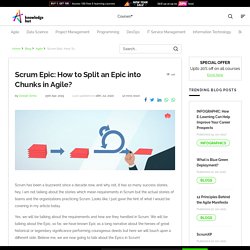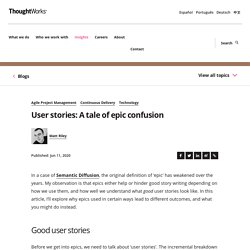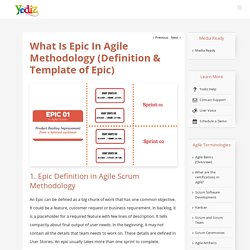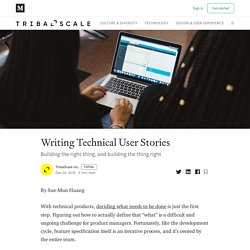

User Story and Epic for the Win (With Examples) - Product Management. It feels like yesterday when I first sat in front of my product backlog.

I saw a lot of lines with cryptic titles, ticket numbers, and different colors. I was completely overwhelmed and didn’t know what to do. If you felt or feel the same, I recommend you continue reading. I want to share how I started and what lessons I learned with user stories and epics that help me manage my backlog today. Let’s have a look at the definition of a backlog: “…the Product Backlog is an ordered list of everything that is known to be needed in the product. There are different opinions about who “owns” the backlog (the Product Manager or the whole squad). Everyone knows what the priorities are, and commits to building a great product 🚀 As Product Manager, you’ll drive the backlog activities and its items, called product backlog items or PBIs. Here's what Subject experts say about an Epic in Agile. Scrum has been a buzzword since a decade now, and why not, it has so many success stories, hey, I am not talking about the stories which mean requirements in Scrum but the actual stories of teams and the organizations practicing Scrum.

Looks like, I just gave the hint of what I would be covering in my article today. Yes, we will be talking about the requirements and how are they handled in Scrum. We will be talking about the Epic, so far, we have known Epic as a long narrative about the heroes of great historical or legendary significance performing courageous deeds but here we will touch upon a different side.
Believe me, we are now going to talk about the Epics in Scrum! User stories: A tale of epic confusion. In a case of Semantic Diffusion, the original definition of ‘epic’ has weakened over the years.

My observation is that epics either help or hinder good story writing depending on how we use them, and how well we understand what good user stories look like. In this article, I’ll explore why epics used in certain ways lead to different outcomes, and what you might do instead. Good user stories Before we get into epics, we need to talk about ‘user stories’. The incremental breakdown of work that user stories yield is essential to agile software development and continuous delivery. If we want good user stories, we need to make it easier to write good ones, and harder to write poor ones.
Agile Planning: Step-by-Step Guide + Template. Overwhelmingly, the world is going agile – a whopping 71% of organizations have adopted agile methodologies, and 90% of agile projects have faster time to market than the average for traditional project management.

What Is Epic In Agile Methodology (Definition & Template of Epic) – Yodiz Project Management Blog. An Epic can be defined as a big chunk of work that has one common objective.

It could be a feature, customer request or business requirement. In backlog, it is a placeholder for a required feature with few lines of description. It tells compactly about final output of user needs. In the beginning, it may not contain all the details that team needs to work on. Acceptance Criteria - What Is It? Examples and Templates Included. Acceptance criteria is essential for when you write user stories.

They help your team understand what's essential and what they should focus on while developing a feature. Let's jump in and look at acceptance criteria in-depth. Technical User Stories – What, When, and How? — RGalen Consulting. It happens to me on a weekly basis.

I’m teaching a class on how to write User Stories. Usually it’s part of my Product Owner workshop. We’re happily writing stories for an iPad application simulation. Typically halfway thru the exercise someone raises their hand because they’re struggling with the format of a purely technical story. Quite often they don’t know how to frame the “user” clause and are stuck there in their writing. My first recommendation is often to tell them to skip it. In fact, I ask them to spend more time on the confirmation or acceptance part of the story, because I find that this is an area that needs “development” for more technical stories. A Technical User Story is one focused on non-functional support of a system.
Another type of technical story focuses more towards technical debt and refactoring. The other difference is that these stories usually need to be defined with someone who understands the technical design and implications of the product stack. Bob. Writing Technical User Stories - TribalScale - Medium. Building the right thing, and building the thing right By Sue-Mun Huang With technical products, deciding what needs to be done is just the first step.

Figuring out how to actually define that “what” is a difficult and ongoing challenge for product managers. Fortunately, like the development cycle, feature specification itself is an iterative process, and it’s owned by the entire team. If you’re building an API, middleware, or any kind of backend product, you’ll likely face these (additional) challenges when defining requirements: Features are often tightly coupled and co-dependentFeatures touch multiple parts of the system (or systems)Small changes can have far-reaching impact — lots of nuances to considerHard to keep end-user value top of mind or explain value to stakeholdersUnfamiliar jargon: highly technical or vendor-specific terms.